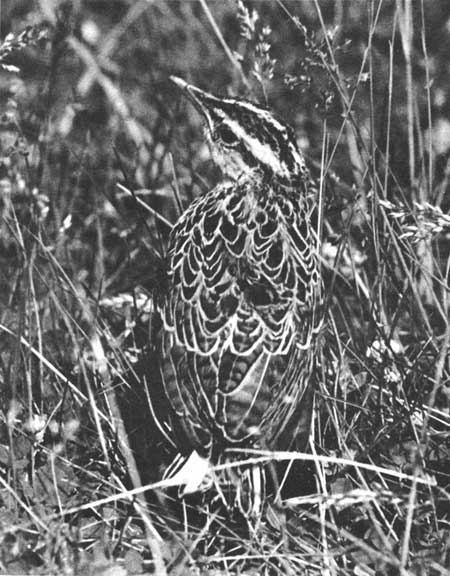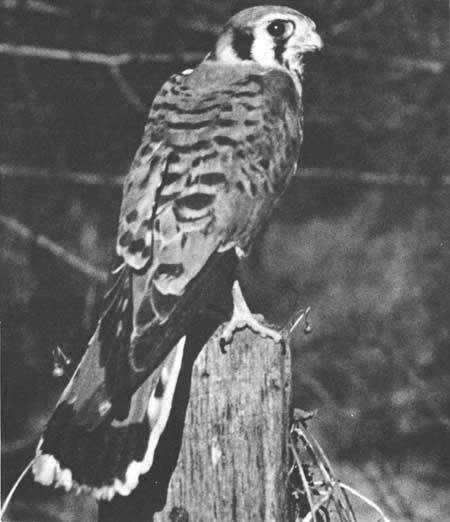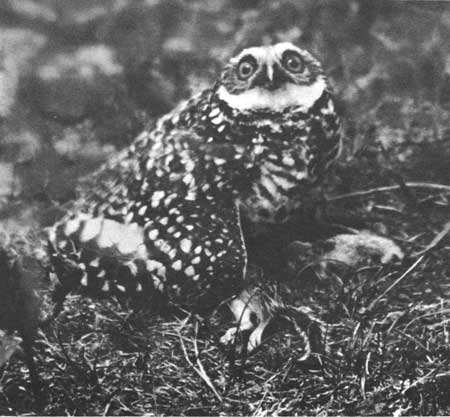|
BADLANDS National Park |
 |
Animals
The animal life of the badlands and vicinity, as of any region, is molded by the vegetation, the type of soil, and availability of water; the climate, which intimately controls the type of vegetation, thus indirectly has great effect upon the animal life. Most of the animals of the badlands are adapted for living in open grassland and for survival with comparatively little water. Many of them are rather pale in coloration. Thus, they blend with the light color of the soil and dry grass and are less easily detected by their enemies.
BIRDS
Birds live under conditions most favorable to their particular needs. The grassland, the occasional groups of small shrubs and juniper, and even the bare canyon walls provide the food and the environments that certain birds require. Some are transients and are here for only a few days in the spring and autumn. Others nest here and return to warmer climes in the winter. A few remain—dwellers of the badlands—the year round. It is not the purpose to list here all the birds, but mention will be made of some of the more common and interesting ones.
Members of the finch family are seedeaters and have strong bills for crushing their food. In this region members of that family prefer the prairie and the margins of the groves that are close to their food supply.
The AMERICAN GOLDFINCH, frequently called the "wild canary," is a charming little yellow songster with black cap, wings, and tail. Often it flits along the roadside, feeding on the seeds of sunflowers and weeds.
The sparrows, which belong to the finch family, are modest-colored birds, and are often difficult to distinguish. One of the common summer residents is the VESPER SPARROW. You will find a good identifying mark in the white outer tail feathers which flash conspicuously in flight. Its song will come to you in the evening from a lone bush or tree.
 Dillon Pass |
The LARK SPARROW likes the open country and the grassy hillsides. The striped crown, chestnut ear-patches, and white breast with a single dark central spot are the best identifying markings. It is a summer resident with a beautiful song.
The song of the CHIPPING SPARROW is a single, prolonged, vibrating trill. A resident of the meadows, the little "chippy" with the bright rufous-red cap is equally at home in the sparsely wooded sections.
The juncos are sparrow-sized, with uniform gray coloration on the back, lighter or contrasting underparts, and white outer tail feathers that flash conspicuously when they fly. Their winter occurrence and gray color help distinguish them from the summer resident, the vesper sparrow. They, like the sparrows, are seedeaters and occur both in the open prairie and in the shrub thickets and sparsely wooded areas.
The SLATE-COLORED JUNCO and the WHITE-WINGED JUNCO are found in the badlands. Common in winter, they are often seen in mixed flocks or with sparrows. The slate-colored junco is distinguished by the slaty-gray back, white bill, and white underparts. The white-winged junco resembles the other in color but is slightly larger and has two prominent, white wing bars.
The LARK BUNTING is distinctly a bird of the prairie and nests on the ground near clumps of weeds or sagebrush. The male, a beautiful singer, is black with large white wing patches. It is often mistaken for a small blackbird or confused with the bobolink. The song, warbling and gurgling, with several distinct phrases, begins as the bird rises in flight and continues until it alights. Females are sparrow-like in color.
Swallows are sparrow-sized with long, slim wings. They capture and eat insects in flight. Both the CLIFF SWALLOW and the VIOLET GREEN SWALLOW can be seen in the badlands. The rusty-buff rump distinguishes the cliff swallow; perceived overhead it appears square-tailed, with a dark throat patch. It builds mud nests in ledges of the badlands formations, or under bridges or roof eaves. The violet green swallow is glossed with green and purple, with clear white below and white patches that almost meet over the base of the tail. Social birds, the two species are often seen together in flocks.
Wrens are small, energetic, brown-backed birds with slender bills, and tails that are often cocked over the back. An inhabitant of canyons and rocky slopes, the CANYON WREN is readily identified by the reddish-brown back and conspicuous white throat and breast. The song is a gushing cadence of clear, curved notes that come tripping down the scale. It nests in rocky crevices.
The ROCK WREN also inhabits rocky places and is one of the few small birds to be seen frequenting the most barren badlands formations. It is easily distinguished from the canyon wren by its lack of a white throat and dark belly. Watch for the white eye streak and buffy tail tips.
Curiously, the BLACK-CAPPED CHICKADEE is a permanent resident in the badlands, most often seen among the junipers. It is the only small bird with the combination black cap, black bib, and white cheeks. Its most common note is the clearly enunciated "chick-a-dee-dee-dee." It becomes more friendly in winter when snow covers much of its normal food supply.
Few people think of the ROBIN as a thrush, but actually it is the most highly developed of that family. To most of us it is just "the robin"—a good neighbor, a dependable friend—the first bird to arrive with its cheering spring song, often before the snow has disappeared. One of the most familiar of all birds, it is easily recognized by its gray back and brick-red breast.
The MOUNTAIN BLUEBIRD, another member of the thrush family, lacks the chestnut breast of its eastern cousin and is azure blue above with a grayish-white belly. The female is a dull brownish, with bluish wings, rump, and tail. As though to accentuate its beauty, it has a delightful habit of hovering on wing like a hummingbird while watching for insects in the grass.
The erratic flight of the COMMON NIGHTHAWK, seen in the late afternoon and evening, is punctuated by frequent regular repetitions of a short, nasal, and utterly unmusical call. The most unusual flight performance is the astonishing aerial dive that the nighthawk executes by almost closing its wings and plunging downward. Suddenly the descent is checked; a weird booming sound is heard as the diver sweeps gracefully upward to renew its flight. It feeds on flying insects that it gathers into its large mouth. Just before and after sunset, nighthawks often are seen swooping and diving over the badlands and adjacent plains. This bird is closely related to the whip-poor-will.
SAY'S PHOEBE is a summer resident about the size of a bluebird. Like others of the flycatcher family, it feeds on flying insects, darting out upon its prey from a perch, usually a limb of a tree an old stump, or an overhanging cliff. The pale rusty breast contrasted to the brownish back and black tail identify it. The phoebe prefers the open prairie country, although, not uncommonly, it builds its home near the habitation of man. Its plaintive call is usually accompanied by a nervous flit of the tail.
The HORNED LARK is one of the first birds to nest in spring, often when snowbanks are still visible. This brown prairie bird is distinctly marked with a black mustache, black breast patch, and a black horseshoe crown terminating in two erect, black horns. It does not hop, but walks. Preferring the open prairie and fields, it lives principally upon weed seeds. During the winter, flocks of horned larks often feed on the shoulders of the highway.
The BLACK-BILLED MAGPIE, a close relative of crows and jays, is the only large black-and-white land bird with a long, sweeping tail. In flight, the iridescent tail streams out behind, and large white patches flash in the wing. The magpie, a year-round resident of the badlands and vicinity, is a scavenger, often seen feeding on animals that have been run over by automobiles on monument roads.
 A western meadowlark hiding in the grass J. S. DIXON PHOTOGRAPH |
The WESTERN MEADOWLARK, a prairie dweller, arrives early in March and lingers in autumn until a severe storm drives it southward. It is somewhat smaller than the eastern meadowlark, but the general coloration of the yellow breast and black crescent at the throat is similar. It feeds chiefly on insects and seeds and builds its nest on the ground. The meadowlark's song can be heard a considerable distance and fairly fills the prairie with its melody.
The TURKEY VULTURE is a large, blackish, eagle-sized bird, usually seen soaring on motionless wings in wide circles high over the cliffs of the badlands. Birds of this family seldom attack living animals, but feed chiefly upon carrion. The nest is built on shelves under overhanging cliffs. The turkey vulture is able to sail for hours with few wing movements. It may be distinguished at a distance from other soaring birds by the upward angle of the wing planes. The BLACK VULTURE, with a black instead of a red, featherless head, is found in few areas so far north; yet it is not uncommon in the badlands. A white spot under each wing and a fan like tail may help distinguish this bird from the more familiar turkey vulture.
A familiar hawk and one of man's best friends is the MARSH HAWK. In ordinary flight the bird glides low over the ground, with the white rump patch, the badge of the species, plainly visible. The nest is built on the ground, hidden in tall grass or brushy thickets. Mice and gophers constitute the bulk of its food, with only a small part coming from small birds and poultry. You should be come familiar with it and aid in its protection. Look for it as you drive along the roads through the badlands.
 The sparrow hawk REX GARRY SCHMIDT PHOTOGRAPH |
Not much larger than the robin, the SPARROW HAWK is the most common of the falcons. It is the only common small hawk that habitually hovers in one spot and the only one with the rufous-red rail. The chestnut back is clearly marked with several black bars and the tail has one wide black bar. The upper parts are bluish slate and the underportions are creamy white with black spots. Its food is chiefly mice; grasshoppers, beetles, and occasionally small birds. Of all the falcons, this is the most beneficial.
 A closeup of a western burrowing owl FISH AND WILDLIFE SERVICE PHOTOGRAPH |
The little BURROWING OWL is found in the badlands. The upper parts are dull grayish brown slightly spotted with white, while the belly is light, barred with brown. The legs appear long for the size of the bird and are feathered only in front. It prefers to build its nest in abandoned holes, or burrows, often taking possession of deserted prairie-dog burrows. Contrary to popular belief, it does not inhabit a burrow occupied at the same time by a prairie dog or rattlesnake.
The food of this little owl consists mostly of small rodents, snakes, lizards, grasshoppers, and beetles.

|

|
|
|
|
Last Modified: Sat, Nov 4 2006 10:00:00 pm PST |


